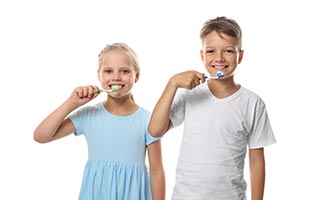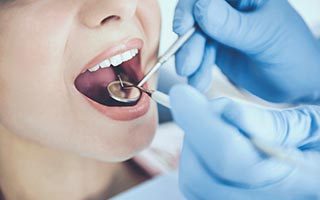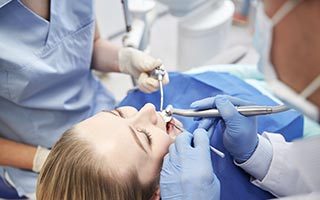Call your dentist promptly. To comfort your child, rinse the mouth with water. Apply a cold compress or ice wrapped in a cloth. Do not put heat or aspirin on the sore area.
CHILDREN’S DENTAL CARE
CHILDREN’S DENTAL CARE
Children’s dental care is not what it used to be. We may be able to pick up on signs of undiagnosed conditions such as obstructive sleep apnoea or wrongly diagnosed medical conditions such as ADHD by looking at your child’s mouth and craniofacial development. Dr Andrew’s Master’s degree in Sleep Medicine and dedication to ongoing education in holistic dentistry and how the mouth and body are connected makes this possible.
Please watch the “Finding Connor Deegan – AAPMD” video below to understand how we may be able to help.
We of course also offer general dentistry to children from comprehensive examinations, hygiene and restorative work. We take things slow and intention is to have your child leave smiling. We always ask them for permission before doing anything as we believe in building a trusting relationship with them.
Educational Video
Frequently Asked Questions
- When should I schedule my child’s first dental visit?
- Are baby teeth really that important to my child?
- What is Baby Bottle Tooth Decay (Early Childhood Caries)? How can it be prevented?
- What is Pulp Therapy / Pulpotomy or Baby root canal?
- When Will My Baby Start Getting Teeth?
- When should I begin brushing my child’s teeth?
- How do I prevent Cavities?
- How do I make my child’s diet safe for his teeth?
- What is a sealant and how does it help prevent decay?
- How do I determine if my child needs fluoride supplements?
- Which is the best toothpaste for my child?
- What is dental fluorosis? How does it affect my child’s teeth? How can it be prevented?
- What is topical fluoride?
- Does my child grind their teeth at night?
- Why do children indulge in thumb sucking?
- Is my child at risk for tooth decay?
- How can I protect my child’s teeth from sport injuries?
- What should I do if my child’s permanent tooth is knocked out?
- What if my child has a toothache?
- What is early orthodontic care?
According to the American Academy of Paediatric Dentistry (AAPD), your child should visit the dentist by his/her 1st birthday. You can make the first visit to the dentist enjoyable and positive. Your child should be informed of the visit and told that the dentist and their staff will explain all procedures and answer any questions. The less to-do concerning the visit, the better.
It is best if you refrain from using words around your child that might cause unnecessary fear, such as needle, pull, drill or hurt. Paediatric dental offices make a practice of using words that convey the same message, but are pleasant and non-frightening to the child such as sleepy juice for the aesthetic, vacuum for the suction and so forth.
It is very important to maintain the health of the primary teeth. Neglected cavities can and frequently do lead to problems which affect developing permanent teeth. Primary teeth, or baby teeth are important for
- proper chewing and eating
- providing space for the permanent teeth and guiding them into the correct position
- and permitting normal development of the jaw bones and muscles
Primary teeth also affect the development of speech and add to an attractive appearance. While the front 4 teeth last until 6-7 years of age, the back teeth (cuspids and molars) are not replaced until age 10-13.
One serious form of decay among young children is baby bottle tooth decay. This condition is caused by frequent and long exposures of an infants teeth to liquids that contain sugar. Among these liquids are milk (including breast milk), formula, fruit juice and other sweetened drinks.
Putting a baby to bed for a nap or at night with a bottle other than water can cause serious and rapid tooth decay. Sweet liquid pools around the child’s teeth giving plaque bacteria an opportunity to produce acids that attack tooth enamel. If you must give the baby a bottle as a comforter at bedtime, it should contain only water. If your child would not fall asleep without the bottle and its usual beverage, gradually dilute the bottle’s contents with water over a period of two to three weeks.
After each feeding, wipe the baby’s gums and teeth with a damp washcloth or gauze pad to remove plaque. The easiest way to do this is to sit down, place the child’s head in your lap or lay the child on a dressing table or the floor. Whatever position you use, be sure you can see into the child’s mouth easily.
The pulp of a tooth is the inner central core of the tooth. The pulp contains nerves, blood vessels, connective tissue and reparative cells. The purpose of pulp therapy in Paediatric Dentistry is to maintain the vitality of the affected tooth (so the tooth is not lost).
Dental caries (cavities) and traumatic injury are the main reasons for a tooth to require pulp therapy. Pulp therapy is often referred to as a “nerve treatment”, “children’s root canal”, “pulpectomy” or “pulpotomy”. The two common forms of pulp therapy in children’s teeth are the pulpotomy and pulpectomy.
A pulpotomy removes the diseased pulp tissue within the crown portion of the tooth. Next, an agent is placed to prevent bacterial growth and to calm the remaining nerve tissue. This is followed by a final restoration (usually a stainless steel crown).
A pulpectomy is required when the entire pulp is involved (into the root canal(s) of the tooth). During this treatment, the diseased pulp tissue is completely removed from both the crown and root. The canals are cleansed, disinfected and in the case of primary teeth, filled with a resorbable material. Then a final restoration is placed. A permanent tooth would be filled with a non-resorbing material.
Teething, the process of baby (primary) teeth coming through the gums into the mouth, is variable among individual babies. Some babies get their teeth early and some get them late. In general the first baby teeth are usually the lower front (anterior) teeth and usually begin erupting between the age of 6-8 months.
Eruption Of Your Childs Teeth
Children’s teeth begin forming before birth. As early as 4 months, the first primary (or baby) teeth to erupt through the gums are the lower central incisors, followed closely by the upper central incisors. Although all 20 primary teeth usually appear by age 3, the pace and order of their eruption varies.
Permanent teeth begin appearing around age 6, starting with the first molars and lower central incisors. This process continues until approximately age 21.
Adults have 28 permanent teeth, or up to 32 including the third molars (or wisdom teeth).
Begin daily brushing as soon as the child’s first tooth erupts. A pea size amount of fluoride toothpaste can be used after the child is old enough not to swallow it. By age 4 or 5, children should be able to brush their own teeth twice a day with supervision until about age seven to make sure they are doing a thorough job. However, each child is different. Your dentist can help you determine whether the child has the skill level to brush properly.
Proper brushing removes plaque from the inner, outer and chewing surfaces. When teaching children to brush, place toothbrush at a 45 degree angle; start along gum line with a soft bristle brush in a gentle circular motion. Brush the outer surfaces of each tooth, upper and lower. Repeat the same method on the inside surfaces and chewing surfaces of all the teeth. Finish by brushing the tongue to help freshen breath and remove bacteria.
Flossing removes plaque between the teeth where a toothbrush can not reach. Flossing should begin when any two teeth touch. You should floss the child’s teeth until he or she can do it alone. Use about 18 inches of floss, winding most of it around the middle fingers of both hands. Hold the floss lightly between the thumbs and forefingers. Use a gentle, back-and-forth motion to guide the floss between the teeth. Curve the floss into a C-shape and slide it into the space between the gum and tooth until you feel resistance. Gently scrape the floss against the side of the tooth. Repeat this procedure on each tooth. Do not forget the backs of the last four teeth.
Good oral hygiene removes bacteria and the left over food particles that combine to create cavities. For infants, use a wet gauze or clean washcloth to wipe the plaque from teeth and gums. Avoid putting your child to bed with a bottle filled with anything other than water.
For older children, brush their teeth at least twice a day. Also, watch the number of snacks containing sugar that you give your children.
The American Academy of Paediatric Dentistry recommends six month visits to the paediatric dentist beginning at your child’s first birthday. Routine visits will start your child on a lifetime of good dental health.
Your paediatric dentist may also recommend protective sealants or home fluoride treatments for your child. Sealants can be applied to your child’s molars to prevent decay on hard to clean surfaces.
Healthy eating habits lead to healthy teeth. Like the rest of the body, the teeth, bones and the soft tissues of the mouth need a well-balanced diet. Children should eat a variety of foods from the five major food groups. Most snacks that children eat can lead to cavity formation. The more frequently a child snacks, the greater the chance for tooth decay. How long food remains in the mouth also plays a role. For example, hard candy and breath mints stay in the mouth a long time, which cause longer acid attacks on tooth enamel. If your child must snack, choose nutritious foods such as vegetables, low-fat yogurt, and low-fat cheese which are healthier and better for children teeth.
A sealant is a clear or shaded plastic material that is applied to the chewing surfaces (grooves) of the back teeth (premolars and molars), where four out of five cavities in children are found. This sealant acts as a barrier to food, plaque and acid, thus protecting the decay-prone areas of the teeth.
How long do sealants last?
Research shows that sealants can last for many years if properly cared for. So, your child will be protected throughout the most cavity-prone years. If your child has good oral hygiene and avoids biting hard objects, sealants will last longer. We will check the sealants during routine dental visits and can recommend reapplication or repair when necessary.
How are sealants placed?
The application of a sealant is quick and comfortable. It takes only one visit. The tooth is first cleaned. It is then conditioned and dried. The sealant is then flowed onto the grooves of the tooth and allowed to harden or hardened with a special light. Your child will be able to eat right after the appointment.
When used in appropriate amounts it encourages “remineralization,” a strengthening of weak areas on the teeth such as the pits and the fissures on the teeth. Fluoride occurs naturally in water and in many different foods, as well as in dental products such as toothpaste, mouth rinses, gels, varnish and supplements. Fluoride is effective when combined with a healthy diet and good oral hygiene.
Children between the ages of six months and 16 years may require fluoride supplements. We consider many different factors before recommending a fluoride supplement. Your child’s age, risk of developing dental decay and the different liquids your child drinks are important considerations. Bottled, filtered and well waters vary in their fluoride amount, so a water analysis may be necessary to ensure your child is receiving the proper amount.
Tooth brushing is one of the most important tasks for good oral health. Many toothpastes, and/or tooth polishes, however, can damage young smiles. They contain harsh abrasives which can wear away young tooth enamel. When looking for a toothpaste for your child make sure to pick one that is recommended by the American Dental Association. These toothpastes have undergone testing to insure they are safe to use.
Remember, children should spit out toothpaste after brushing to avoid getting too much fluoride. If too much fluoride is ingested, a condition known as fluorosis can occur. If your child is too young or unable to spit out toothpaste, consider providing them with a fluoride free toothpaste, using no toothpaste, or using only a “pea size” amount of toothpaste.
Fluoride is an element, which has been shown to be beneficial to teeth. However, too little or too much fluoride can be detrimental to the teeth. Little or no fluoride will not strengthen the teeth to help them resist cavities. Excessive fluoride ingestion by preschool-aged children can lead to dental fluorosis, which is a chalky white to even brown discolouration of the permanent teeth. Many children often get more fluoride than their parents realise. Being aware of a child’s potential sources of fluoride can help parents prevent the possibility of dental fluorosis.
Some of these sources are:
- Too much fluoridated toothpaste at an early age
- The inappropriate use of fluoride supplements
- Hidden sources of fluoride in the child’s diet
Two and three year olds may not be able to expectorate (spit out) fluoride-containing toothpaste when brushing. As a result, these youngsters may ingest an excessive amount of fluoride during tooth brushing. Toothpaste ingestion during this critical period of permanent tooth development is the greatest risk factor in the development of fluorosis.
Excessive and inappropriate intake of fluoride supplements may also contribute to fluorosis. Fluoride drops and tablets, as well as fluoride fortified vitamins should not be given to infants younger than six months of age. After that time, fluoride supplements should only be given to children after all of the sources of ingested fluoride have been accounted for and upon the recommendation of your dentist.
Certain foods contain high levels of fluoride, especially powdered concentrate infant formula, soy-based infant formula, infant dry cereals, creamed spinach, and infant chicken products. Please read the label or contact the manufacturer. Some beverages also contain high levels of fluoride, especially decaffeinated teas, white grape juices, and juice drinks manufactured in fluoridated cities. Another source of fluoride can be found in soft drinks at fast food restaurants, when blending the syrup and carbonation with the city water supply.
Parents can take the following steps to decrease the risk of fluorosis in their children teeth:
- Use baby tooth cleanser on the toothbrush of the very young child
- Place only a pea sized drop of children toothpaste on the brush when brushing
- Account for all of the sources of ingested fluoride before requesting fluoride supplements
- Avoid giving any fluoride-containing supplements to infants until they are at least 6 months old Obtain fluoride level test results for your drinking water before giving fluoride supplements to your child (check with local water utilities)
Topical fluoride is applied on cleaned tooth surfaces to strengthen teeth and help fight decay.
Children who benefit the most from fluoride are those at highest risk for dental decay. Risk factors include a history of decay, high sucrose carbohydrate diet, orthodontic appliances and certain medical conditions such as dry mouth.
Parents are often concerned about the nocturnal (night time) grinding of teeth (bruxism). Often, the first indication is the noise created by the child grinding on their teeth during sleep. Or, the parent may notice wear (teeth getting shorter) to the dentition. One theory as to the cause involves a psychological component. Stress due to a new environment, divorce, changes at school; etc. can influence a child to grind their teeth. Another theory relates to pressure in the inner ear at night. If there are pressure changes (like in an airplane during take-off and landing when people are chewing gum, etc. to equalise pressure) the child will grind by moving his jaw to relieve this pressure.
The majority of cases of paediatric bruxism do not require any treatment. If excessive wear of the teeth (attrition) is present, then a mouth guard (night guard) may be indicated. The negatives to a mouth guard are the possibility of choking if the appliance becomes dislodged during sleep and it may interfere with growth of the jaws. The positive is obvious by preventing wear to the primary dentition.
The good news is most children outgrow bruxism. The grinding gets less between the ages 6-9 and children tend to stop grinding between ages 9-12..
Sucking is a natural reflex and infants and young children may use thumbs, fingers, pacifiers and other objects on which to suck. It may make them feel secure and happy or provide a sense of security at difficult periods. Since thumb sucking is relaxing, it may induce sleep.
Thumb sucking that persists beyond the eruption of the permanent teeth can cause problems with the proper growth of the mouth and tooth alignment. How intensely a child sucks on fingers or thumbs will determine whether or not dental problems may result. Children who rest their thumbs passively in their mouths are less likely to have difficulty than those who vigorously suck their thumbs.
Do children eventually give up the habit?
Children should cease thumb sucking by the time their permanent front teeth are ready to erupt. Usually, children stop between the ages of two and four. Peer pressure causes many school-aged children to stop.
Pacifiers are no substitute for thumb sucking. They can affect the teeth essentially the same way as sucking fingers and thumbs. However, use of the pacifier can be controlled and modified more easily than the thumb or finger habit.
Below are some suggestions to help children stop their habit:
- Instead of scolding children for thumb sucking, praise them when they are not
- Children often suck their thumbs when feeling insecure. Focus on correcting the cause of anxiety, instead of the thumb sucking
- Children who are sucking for comfort will feel less of a need when their parents provide comfort
- Reward children when they refrain from sucking during difficult periods, such as when being separated from their parents
- Encourage children to stop sucking and explain what could happen if they continue
- If these approaches do not work, remind the children of their habit by bandaging the thumb or putting a sock on the hand at night.
Developing malocclusions, or bad bites, can be recognised as early as 2-3 years of age. Often, early steps can be taken to reduce the need for major orthodontic treatment at a later age.
Stage I – Early Treatment: This period of treatment encompasses ages 2 to 6 years. At this young age, we are concerned with underdeveloped dental arches, the premature loss of primary teeth, and harmful habits such as finger or thumb sucking. Treatment initiated in this stage of development is often very successful and many times, though not always, can eliminate the need for future orthodontic/orthopaedic treatment.
Stage II – Mixed Dentition: This period covers the ages of 6 to 12 years, with the eruption of the permanent incisor (front) teeth and 6 year molars. Treatment concerns deal with jaw malrelationships and dental realignment problems. This is an excellent stage to start treatment, when indicated, as your child’s hard and soft tissues are usually very responsive to orthodontic or orthopaedic forces.
Stage III – Adolescent Dentition: This stage deals with the permanent teeth and the development of the final bite relationship.
When a child begins to participate in recreational activities and organised sports, injuries can occur. A properly fitted mouth guard, or mouth protector, is an important piece of athletic gear that can help protect your child’s smile, and should be used during any activity that could result in a blow to the face or mouth.
Mouth guards help prevent broken teeth, and injuries to the lips, tongue, face or jaw. A properly fitted mouth guard will stay in place while your child is wearing it, making it easy for them to talk and breathe.
According to the American Dental Association, the difference between saving and losing a knocked out tooth, is the thirty minutes following the incident.
To save the tooth, follow these steps:
- Avoid scrubbing the tooth
- Insert the tooth into the empty socket quickly
- If you are uncomfortable inserting the tooth, put the tooth in milk or water
- Get to the dentist immediately
Common dental emergencies
Chipped or Fractured teeth
Although teeth are the strongest substance in the whole body, they may chip or break due to various reasons. Some of the most common reasons are biting into something hard accidentally, tooth with a large filling, root canal treated tooth that is not capped and tooth undermined due to decay.
What to expect?
Depending on the extent of fracture your tooth may be sensitive to temperature and pressure changes. Rinse your mouth gently with lukewarm water. Take a pain reliever if needed. See your dentist as soon as possible so he can determine the course of treatment.
How is it treated?
Fractures may involve only the superficial outer part of the tooth (enamel). In such a case your dentist may lightly polish the area to smooth the rough surfaces or place a filling and observe the tooth for further changes.
If the fracture involves the enamel and the inner sensitive dentin your dentist may have to place a crown due to the extent of involvement. This will protect the tooth and prevent further damage. Sometimes fractures may involve the enamel, dentin and the nerve tissue inside the tooth. This will necessitate a root canal treatment and a crown. If the crack extends beyond the gum line it may require a crown lengthening procedure, which involves removal of bone to grasp enough healthy structure for the crown.
However, if the crack extends to the root the tooth cannot be saved and will have to be removed.
To learn more about early orthodontic care, please visit Orthodontic Consultations FAQ’s.

ALL SERVICES

GENERAL DENTISTRY
Check-ups, Fillings, Extractions, Children’s dental care, Mouthguards and more! Learn more



TMJ & SLEEP THERAPY
Chronic Pain of the Head and Neck, Sleep Apnea, Anti-Snoring Devices and more! Learn more
CONTACT US AND BOOK IN YOUR VISIT
WORKING HOURS
ADDRESS
119A Brighton Rd
Sandgate QLD 4017
Get in touch today!
The friendly team at Dental Seasons look forward to guiding you through all of your dentals needs!
CALL OR EMAIL US
+61 7 3269 2064
info@dentalseasons.com.au
VISIT US
119A Brighton Road
Sandgate QLD 4017
© 2022 Dental Seasons. Website created by Switch Collaborative | Sitemap
